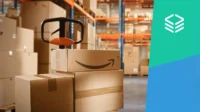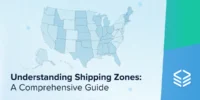E-commerce makes life easy for the consumer. Simply click a button on the computer and POOF… a package magically appears at the door. Behind the apparent magic of e-commerce is a veritable army of men and women working tirelessly to sate the nation’s online shopping addiction. It’s never been more important to have your e-commerce business fined tuned like an oiled machine.
As an e-commerce business, you perform magic every day. These Best Practices for E-commerce Warehousing will save you show time and money, but they will also give you the tricks you need to keep the magic alive for your customers.
1. Target Two-Day Shipping
Nothing kills the magic of an e-commerce business like slow shipping. That’s why the major online retailers like Amazon, Target, and Walmart strive for two-day shipping, if not same-day delivery. Though your operation is likely smaller than Amazon’s, it’s still best practice to offer what they offer, fast shipping.
2. Combine Traditional and E-Commerce Warehouses
You don’t need two warehouses to store traditional inventory and e-commerce inventory. In fact, best practice is to combine traditional retail, B2B, and e-commerce warehousing operations under one roof.
Try to use different sections of the facility for specific e-commerce or traditional fulfillment purposes. This strategy will not only save you money, but it will also make it easier to scale your operation.
3. Build a Touch-Plan Strategy
The more touch points an order has, the longer it takes to get it to the customer. Slow is bad. Fast is good. That’s why one of the best practices for e-commerce warehousing is to employ a touch-plan strategy, in which touch points are reduced to the bare minimum, i.e., single-item orders have only one touchpoint, and touch points for multi-item orders are limited to the number of items in the order.
You can make life easier for your pickers, packers, and loaders by employing an indicator or alert label that clearly identifies different types of shipments.
4. Integrate Warehouse and Fulfillment Management Systems
Your warehouse may be huge, but it’s only a small part of the product cycle. As such, it’s best practice to combine your existing warehouse, fulfillment, and transportation management systems into an all-encompassing system. By combining systems you not only reduce delays, but you also make it easier on your employees who no longer have to switch between systems to do their jobs.
5. Embrace New Technology
The new technologies currently driving order fulfillment demonstrate a concentrated effort on behalf of 3PL’s, e-commerce businesses, and supply chain industry leaders to drive down fulfillment costs and improve the overall client experience.
Progressive fulfillment providers understand this cycle of technological improvement and the value that it provides to their customer. We did the math, and the most significant advances in order fulfillment are coming from the integration of new technologies like:
- Automation – Technological advancements in order management have automated systems that record and consolidate orders from multiple sources in one place, thereby enabling fulfillment centers to support product offers and promotions; manage payment processing and continuity; perform customer service activities and enable better management of the overall customer relationship.
- Augmented Reality – If current labor trends continue, labor is going to becoming harder to find. Faced with a dire lack of skilled and unskilled labor, fulfillment centers are turning augmented reality technology to improve the speed, skill, and efficiencies of their current employees. Wearable AI devices like smart glasses are now in use by companies like DHL, who utilize the technology to help shop floor pickers determine where to place goods in a cart.
- Artificial Intelligence – Powered by AI, e-commerce warehouse robotics systems can boost the efficiency of pick/pack operations by selecting the most efficient picking routes and eliminating unnecessary routes through the warehouse.
6. Manage Returns Quickly
Returns are more than a simple nuance for shippers – they are a critical element of customer service and the only way to provide consumers with the peace of mind they crave when shopping online. Large-scale online retailers, like Amazon and Wal-Mart, are serving consumers with unparalleled return options.
Unfortunately, this makes consumers are far less likely to complete an online purchase if return policies are non-existent or too expensive. In fact, many consumers will simply avoid your products if they can’t return it or it doesn’t come with a “satisfaction guarantee”. Therefore, it’s now best practice for eRetailers to offer free return shipping and a speedy return process.
7. Consider On-Demand Warehousing
On-demand warehousing is the innovative new warehousing and distribution model that connects available warehousing space with businesses that only need a small amount of space, for a short amount of time.
This enables retailers to dynamically deploy different inventory volumes to different warehouses across the country in little to no time, thus expanding your previous distribution network into a comprehensive and responsive supply chain that is ideally suited to the ever-changing e-commerce marketplace.
Contact Flowspace Today To Help Your E-Commerce Business
If the warehousing and distribution industry has learned anything over the last decade, it’s that best practice is to be flexible. On-Demand Warehousing fills a desperate need for eRetailers but, more importantly, On-Demand Warehousing enables businesses to readily respond to demand without exerting the extra cost, time and effort of securing a warehouse.
That’s where Flowspace comes in. With 1000+ warehouses nationwide, Flowspace is the best practice you can employ for your e-commerce business. Our strategy is customer-driven and optimized to increase the size, speed and scope of your e-commerce operation.
Different from traditional 3PLs, we enable online retailers with the flexibility they need to gain a strategic advantage over their competition and ensure their customers get what they want when they want it. If you’re looking to improve your e-commerce business, then contact Flowspace.





